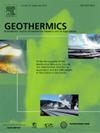调整内管位置并考虑弯曲效应的双管地埋管换热器性能研究
IF 3.9
2区 工程技术
Q3 ENERGY & FUELS
引用次数: 0
摘要
地源热泵(GSHP)系统可以将储存在地下的热能提取出来,用于我们的日常生活中。地热交换器是地源热泵系统的重要组成部分。本文研究了双管GHE在两种实际安装情况下的性能:内管远离中心移动和内管弯曲。采用聚氯乙烯(PVC)和高密度聚乙烯(HDPE)作为内胎材料。由于在安装过程中不使用支撑板时,内管会远离中心,因此通过将PVC内管移动到离中心12.5 mm、22.5 mm和32.5 mm的不同距离,对GHE的性能进行了数值测试。然而,内胎又长又细,可以弯曲。由于HDPE比PVC更柔韧,因此在一个案例中测试了PVC的性能,涉及4个弯,在三个案例中测试了HDPE的性能,涉及4、8和12个弯。对各工况下的出口温度、压降、热交换率和温度分布进行了数值分析,并与常规工况进行了比较。当内管远离中心时,热交换率与传统热交换率的偏差分别为3.68%、3.06%和0.45%。与传统直管相比,PVC管的弯曲情况变化为1.09%,HDPE管的弯曲情况变化为0.93%,2.28%和3.54%。在弯曲条件下,热交换率和压降均略有增加。当内管靠近外壁时,性能下降不显著。研究结果表明,通过使用支撑板将内管保持在中心位置并不是保持最大传热的关键。本文章由计算机程序翻译,如有差异,请以英文原文为准。
Performance investigation of double tube ground heat exchanger by adjusting the inner tube position and consideration of bending effect
The thermal energy that is stored in the ground can be extracted and used in our daily lives by a ground-source heat pump (GSHP) system. A ground heat exchanger (GHE) is a very important part of the GSHP system. This study investigates the performance of double tube GHE under two practical installation scenarios: moving the inner tube away from the center and bending of the inner tube. Polyvinyl chloride (PVC) and High-density polyethylene (HDPE) were utilized as inner tube materials. The performance of GHE was numerically tested by moving the PVC inner pipe at various distances, including 12.5 mm, 22.5 mm, and 32.5 mm from the center, since the inner tube moves away from the center when the support plate is not used during installation. The inner tube, which is long and thin, bends, however. Because HDPE is more flexible than PVC, the performance was tested in one case for PVC, involving 4 bends, and three cases for HDPE, involving 4, 8, and 12 bends. The outlet temperature, pressure drop, heat exchange rate, and temperature distribution are numerically analyzed and compared with conventional for each of those scenarios. When an inner tube moves away from the center, the heat exchange rate deviates from traditional by 3.68 %, 3.06 %, and 0.45 %, respectively. In comparison to straight traditional, the bending scenario showed a 1.09 % change for PVC pipe and a 0.93 %, 2.28 %, and 3.54 % change for HDPE pipe. The rate of heat exchange and the pressure drop both slightly increased in the bending condition. When the inner pipe was closer to the outer wall, the degradation of the performance was not significant. The findings suggest that keeping the inner pipe in center position by using support plates is not crucial to maintain maximum heat transfer.
求助全文
通过发布文献求助,成功后即可免费获取论文全文。
去求助
来源期刊

Geothermics
工程技术-地球科学综合
CiteScore
7.70
自引率
15.40%
发文量
237
审稿时长
4.5 months
期刊介绍:
Geothermics is an international journal devoted to the research and development of geothermal energy. The International Board of Editors of Geothermics, which comprises specialists in the various aspects of geothermal resources, exploration and development, guarantees the balanced, comprehensive view of scientific and technological developments in this promising energy field.
It promulgates the state of the art and science of geothermal energy, its exploration and exploitation through a regular exchange of information from all parts of the world. The journal publishes articles dealing with the theory, exploration techniques and all aspects of the utilization of geothermal resources. Geothermics serves as the scientific house, or exchange medium, through which the growing community of geothermal specialists can provide and receive information.
 求助内容:
求助内容: 应助结果提醒方式:
应助结果提醒方式:


